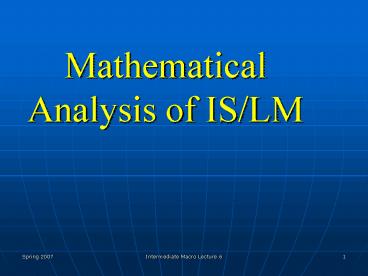Mathematical Analysis of ISLM PowerPoint PPT Presentation
1 / 18
Title: Mathematical Analysis of ISLM
1
Mathematical Analysis of IS/LM
2
IS and LM - Algebra
IS
LM
Substitute in for i in the IS
Bring the Ys to the left
Solve for equilibrium
3
Fiscal Multiplier
The fiscal multiplier is
4
FM and Parameters
Small h implies this is zero (vertical LM,
complete crowding out). Large h implies this
reaches aG approaches (horizontal LM, liquidity
trap, no crowding out)
The larger is b, the more sensitive investment is
to the interest rate, and the smaller is the FM.
The larger the initial multiplier effect, the
larger the FM
Exercise dFM/dk
5
Money Multiplier
The money multiplier is
Note that this is just
(b/h)FM.
6
MM and Parameters
These will vary with the parameters of the system
as follows
This means that as the LM gets steeper the money
multiplier gets large
As investment becomes more sensitive to the
interest rate, the money multiplier gets larger
The larger is the multiplier, the larger the
money multiplier
7
Crowding Out
The new level of equilibrium income is
8
Net Stimulus
The feedback effect is coming through interest
rates.
The amount by which equilibrium income increases
overall is a function of the degree of crowding
out. Our increase in G reduces investment by 2.5
units. What is the net injection to the economy
?G-?I5-2.52.5. There is only a 2.5 unit
increase in AD not 5 because of the increase in
interest rates.
Now let's see this directly in our IS/LM graph.
Recall that fiscal policy shifts our IS function.
As we can see in the previous graph, the amount
of crowding out depends on the slope of the LM. A
horizontal LM results in no crowding out. aG is
the multiplier which results when interest rates
don't change at all.
9
Parameters and the FM
We recall that when h, the interest elasticity of
money demand gets smaller the LM gets steeper.
From the previous graph, we see that with a
steeper LM, the fiscal multiplier is smaller.
(Exercise explain this economically).
Let's now verify numerically that as h? , the
fiscal multiplier FM? . Decrease h from 2 to 1,
0.5Y-i16i0.5Y-16
Substitute into the IS
Y120-4(0.5Y-16)120-2Y643Y184
Yeq61.33
Y has fallen because ieq0.5(61.33)-1614.665
has risen. Again add G5.
Y140-2Y643Y204Yeq68.
?Y/?G 68-61.33/51.334 ieq0.5(68)-1618
10
Economics of the Smaller FM
Investment is smaller (dont worry that it is
negative), as is equilibrium income, because
there is a bigger change in interest rates when h
is smaller ?ieq18-14.665gt13.5-11. A lower
interest sensitivity means bigger changes in i
are needed to equate demand and supply in the
money market. General equilibrium again!
11
Factors Affecting the FM
Let's now trace all the factors that will result
in a large fiscal multiplier. Economically, we
could say that we want factors that will minimize
crowding out. Goods Market - Primary impact
G?AD?Y?. This initial effect will be larger, the
larger is aG. In a simple model, this will be
governed by the marginal propensity to consume,
c.
Asset Market - Feedback effects Y?L?. The
parameter k, the income elasticity of money,
dictates by how much the function L shifts in
response to an increase in money demand. We want
this function to shift only by a small amount.
Small k. L?i?. We want interest rates to go up
by as little as possible. Big h. Along the
flatter (more inelastic demand) curve, interest
rates increase more in response to a shift in L.
Goods Market again i?I?.We want investment to
change as little as possible given the change in
i. Small b is desirable.
12
A Change in the Money Supply
Return to our model of the first section. Let's
increase the money supply by 5 and see the impact
on the level of output. Setting money demand
equal to money supply, M21
0.5Y-2i21/1.
Solving for the new LM,
2i0.5Y-21 ieq 0.25Y-10.5
Note that this represents a parallel shift out in
the LM.
Resolve for equilibrium income using the original
IS
Y120-40.25Y-10.52Y162 Yeq 81
The new equilibrium interest rate is
i0.2581-10.59.75.
13
Money Multiplier
The money multiplier is defined as
MM?Y/?M(81-76)/51.
14
Factors Affecting the MM
What factors will give rise to a large money
multiplier. Ironically, we want many things
opposite to that of the FM case. Asset
Market M?i? . We now want as large as possible a
change in interest rates. Small h.
Goods Market i?I? . Given the change in interest
rates, we want as large an investment response as
possible. Large b. I?AD?Y? . Given the change
in AD, we want this to be multiplied by as much
as possible. Large aG .
Asset Market Y?L?i? . Now we want as little
feedback as possible from transactions demand.
This means small k
15
Multiplier Summary
16
Tailoring Policy
Certain policies then will be better suited for
different economies at different times (1) The
U.S. during the Great Depression The case
involves a liquidity trap with negative net
investment. This obviously calls for fiscal
policy, something we didn't get until WW II.
17
Japans Great Slowdown
Japan had a stock market bubble similar to ours
that began to burst in January 1990. The Nikkei
was at 39,000 and is currently at around 9,000.
Japanese overnight rates which were at 4.25 in
early 1990 were initially raised until mid 1991.
They were slowly lowered to 0.50 in September
1995. Japan has been in a zero interest rate
environment ever since. In March 2002, they fell
to 0.10.
18
Two Other Cases
(2) The U.S. with huge budget deficit In this
case, the government feels constrained not to G?
. (3) Accommodating monetary policy The monetary
authority creates enough money to prevent
interest rates from rising and choking off the
effects of expansionary fiscal policy. With a
horizontal LM represents accommodating monetary
policy). A moral to be drawn is that the
effect of macroeconomic policies is intimately
affected by microeconomic relationships.

